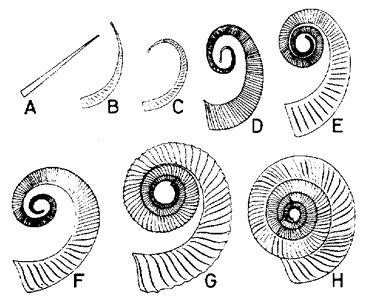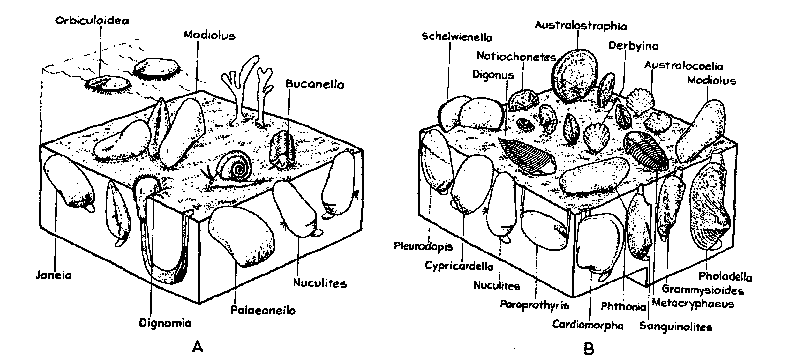
| Palaeos: Paleozoic |  |
Early Devonian Epoch |
| Devonian Period | Emsian Age |
| Page Back | Back: Pragian | Back: Pridoli | Up: Early Devonian | Unit Home |
| Page Next | Next: Eifelian | Next: Middle Devonian | Timescale |

The Emsain age saw the evolution of a new and important cephalopod group, the Ammanoids. They appear suddenly at the start of the epoch, evolving from straight-shelled Bactritids in the space of no more than a million years or so (and quite probably a lot less. By the end of the epoch, a period of no more than four or five million years, they were world-wide in their distribution and diverse in form. Here we have a classic illustration of an evolutionary radiation, such as occurs frequently in the history of life when a new life-form appears and moves into a vacant or quasi-vacant ecological niche.
Early Emsian ammonoids include Anetoceras, Teicherticeras, Convoluticeras, Talenticeras, Mimagoniatites, and the bactrid proto-ammonoids Lobobactrites and Cyrtobactrites. It is even possible to trace a morphological succession between these forms, from the tiny straight shelled bactritids to the larger coiled types. This is shown in the diagram at the top of the page.
Apart from the Bactritids, which are ammonoid - nautiloid transitional forms, all these early ammonoids belong to the suborder Anarcestina of the order Anarcestida. All have extremely simple suture lines.
These cephalopods were nectonic, ocean-going forms, and even at this very early date had a world-wide distribution, being known not only on the western side of the Armorican micro-continent (Germany and Spain, with a possible Euramerican record from England), but also from Antarctic southeast Gondwana (southeast Australia). This same Anetoceras-Erbenoceras-Teicherticeras ammonoid faunas is also known (whether from earliest or later Emsian) from west Armorica (Czechoslovakia) south to northern and central Gondwana coast (Morocco and Turkey), east to the Chinese terraine, as well as north to the north-easternmost part of Euramerica (northern part of the Ural geosyncline), and north-western (Canadian Arctic) and western (Nevada) part of the continent.
By the Late Emsian genera include Taskanites, Sellanarcestes, Mimosphinctes, Palaeogoniatites and Cyrtoceratites, and the bizarre Augurites and Celaeceras. By this time the division of the early ammonoids into the Anarcestina and Agoniatitina had been achieved.
Despite their early widespread distribution, the ammonoids remained a minor group throughout the Emsian. Known faunas are relatively few and at most localities specimens are rare.
| Division |
|
Zone - pollen (A) | Zone - pollen (B) |
|
| patulus | douglastownense/eurypterota |
|
|
|
| Later |
|
|
||
| a
|
serotinus | |||
| a
|
inversus/laticostatus |
|
||
| Earlier
|
perbonus/gronbergi |
|
||
| a
|
dehiscens | Anetoceras hunsrueckianum |
conodont and pollen info from G.C. Young, "Middle Palaeozoic Macrovertebrate Biostratigraphy of Eastern Gondwana," in John A. Long ed., Palaeozoic Vertebrate Biostratigraphy and Biogeography, (1993; John Hopkins University Press, Baltimore, 1994 ed.) p.212, fig.9.2
ammonoid info from ( a book that unfortunately has a different
series of conodont zones for the same time period!)
the correlation of ammonoid zones with the other
zones is guess work, so hopefully some kind straigrapher will one day come
across this page and point out the actual correlation.

During Emsian time faunas are widely recognized throughout Gondwana (southern South America, South Africa, and Antarctica) as constituting a distinct and well-represented Malvinokaffric province. An Appalachian source is likely for the bulk of the Malvinokaffric fauna; an Old World source has been ruled out for most of the Malvinokaifric brachiopod assemblage.
Meanwhile, the Old World province has become divisible into a number of subprovinces, i.e., the Rhenish-Bohemian, Uralian, Tasman, New Zealand, and Cordilleran. But with the disappearance of the Malvinokaffric from central and south Gondwana (South Africa and Antarctica) before the end of the Emsian, bioregionalism then became limited to the Appalachian and Old World provinces.
| Page Back | Unit Home | Page Up | Page Top | Page Next |